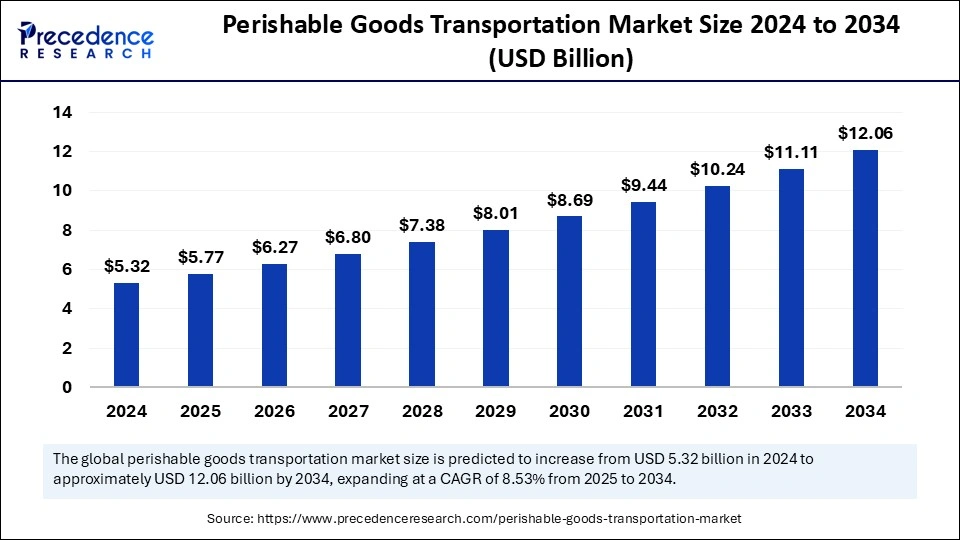Perishable goods transportation market size to expand from USD 5.32 billion in 2024 to USD 12.06 billion by 2034, registering a CAGR of 8.53%.

Perishable Goods Transportation Market Key Takeaways
-
In 2024, North America dominated the perishable goods transportation market.
-
Asia Pacific is forecasted to experience the most rapid growth in CAGR over the forecast duration.
-
Among types, the MPS segment secured the largest market share in 2024.
-
The dairy and frozen desserts segment is expected to expand at the fastest CAGR by type.
-
The road transportation mode led the market in 2024 with the highest share.
-
The air transportation mode is projected to see the fastest CAGR growth through the forecast period.
Perishable Goods Transportation Market Overview
The Perishable Goods Transportation Market plays a vital role in the global economy, ensuring that goods requiring specific environmental conditions are delivered safely and on time. This includes sectors such as fresh food, horticulture, and healthcare, where delays or temperature deviations can result in significant losses.
The rise in consumer demand for high-quality, fresh products and the increase in pharmaceutical exports has expanded the scope of cold chain logistics worldwide. As supply chains become more interconnected, there is a growing need for integrated solutions that ensure product integrity from origin to destination.
Perishable Goods Transportation Market Drivers
Rising international trade of perishable food items and pharmaceutical products is a key driver for the market. The proliferation of modern retail formats, supermarkets, and hypermarkets has led to a surge in the need for refrigerated transportation. Technological advancements in temperature control systems, telematics, and logistics automation have further facilitated market growth.
The healthcare industry’s expansion, especially following the COVID-19 pandemic, emphasized the necessity of cold storage for vaccine and medicine transportation, further driving demand for reliable and compliant refrigerated logistics systems.
Perishable Goods Transportation Market Opportunities
The market is ripe with opportunities in last-mile delivery solutions and multi-modal transportation networks. Investment in digital logistics platforms that provide end-to-end visibility and analytics is creating value for service providers and customers alike. Growth in the pharmaceutical sector, especially in developing regions, opens new avenues for cold chain expansion.
The increasing focus on reducing food waste globally also encourages governments and organizations to invest in better perishable goods transportation infrastructure. Customization of vehicles and containers for specific product types—such as dual-temperature trucks—is another area of potential growth.
Perishable Goods Transportation Market Challenges
The market faces several challenges including inconsistent temperature control, logistical bottlenecks, and rising transportation costs. Infrastructural limitations in developing regions often lead to product spoilage and loss. Regulatory discrepancies between countries regarding cold chain transport add another layer of complexity to international logistics. The high cost of refrigerated vehicles and maintenance also makes it difficult for smaller operators to enter or scale within the market. Environmental concerns surrounding the carbon footprint of refrigerated transport also call for innovation in sustainable technologies.
Perishable Goods Transportation Market Regional Insights
North America continues to lead the market with well-established cold chain networks and a strong regulatory environment. Europe, particularly Western countries, also shows steady growth, driven by cross-border trade and health sector requirements. The Asia-Pacific region is witnessing exponential growth due to increasing urban consumption, large-scale food exports, and significant investment in logistics infrastructure. Latin America and Africa are gradually building capabilities through partnerships, government funding, and private investment, although challenges around road conditions and energy access still persist.
Perishable Goods Transportation Market Recent Developments
Recent innovations in the perishable goods transportation market include the integration of AI for predictive route planning and blockchain for product traceability. Companies are launching next-gen refrigerated containers that allow precise environmental control and remote diagnostics. Cold chain service providers are increasingly focusing on energy efficiency and adopting electric vehicles for urban deliveries. Strategic mergers between transport and tech firms are also creating specialized solutions tailored to specific industry needs. COVID-19 has further accelerated the push for robust vaccine logistics platforms and global supply chain transparency.
Perishable Goods Transportation Market Companies
- Africa Express Line Limited
- Bay & Bay Transportation
- C.H. Robinson Worldwide Inc
- CMA CGM Group (MERIT France SAS)
- DB Schenker
- Deutsche Post AG
- FST Logistics Inc
- Hapag-Lloyd AG
- Hellmann Worldwide Logistics SE
- K Line Logistics Ltd (Kawasaki Kisen Kaisha Ltd)
Segments Covered in the Report
By Type
- MPS
- Dairy and Frozen Desserts
- Vegetables & Fruits
- Bakery & Confectionery
By Mode of Transportation
- Rail Transportation
- Air Transportation
- Marine Transportation
- Road Transportation
By Geography
- North America
- Europe
- Asia Pacific
- Latin America
- Middle East and Africa
Ready for more? Dive into the full experience on our website!